2020-2021 PreK-12 SI Roadshow Highlights
H.E.M. Junior/Senior High- STEM Friday
On Friday, October 15th,2021 the University of Wyoming Science Initiative Roadshow joined the Hanna, Elk Mountain, Medicine Bow (H.E.M) Junior/Senior high students for the school’s STEM Friday. Sixty-five 7th-12th grade students spent the day rotating to five different hands-on STEM demonstrations spanning topics of microbiology, physiology, engineering, comparative ecology, and neuroscience.
Graduate student Brett Ralston created a demonstration on how the lungs function to bring air into the human body. Students were able to build on their answers at the beginning of the demonstration on how we breathe by talking about pressure changes and gas exchange in the body. Austin Bernard, a UW undergraduate student, led an interactive station about engineering supplemented with samples from the UW Makerspace including 3D printed materials. The students then competed with one another to build catapults and discuss the successes and pitfalls of their designs. When students entered the classroom with Mark Lyford, they were greeted with over 15 cast skulls of different animal species. The students learned and reviewed the concepts of omnivores, herbivores, and carnivores, discussing the structural anatomy of the teeth for each of these classifications. Students then tried to identify the animal species of each skull deciding if they were a carnivore, omnivore, or herbivore based on their structure. Justin Kinney is a molecular biology student and wanted the students to learn how microbiology relates to their everyday life. Justin designed a hands-on activity that taught the students about the role of bacteria in the development of ACNE. Students were able to view slides Justin provided under the microscope and draw conclusions about their observations. Lastly, Karagh Brummond took the students on a tour of the brain through demonstrations related to the senses. Students first viewed actual brain specimens from five different species, talking about their comparative anatomy. They then tested their sense of touch through the two-point discrimination task, learned about the role of neuroprosthetics by using muscle electrodes to operate a robotic claw, and lastly, discussed their sense of taste through an experiment using supertaster strips.
The HEM students had many great things to say from the experience:
"I liked how we got to see all the different brains and their sizes" -7th Grade Student
"Looking at microscopes were cool" -7th Grade Student
"I liked how hands-on the activities were, that we could actually touch the skulls in the ecosystem class." -7th Grade Student
"It was fun learning about the students who were presenting majors, and seeing how interesting they found their studies, and that they wanted to present it to us!" -7th Grade Student
"I think that the STEM day on Friday was Amazing! Everyone who came down to teach was professional and spoke about interesting topics. Everything went smoothly and I learned a lot!" -9th Grade Student
"The STEM day was awesome because the teachers were so fun. My favorite activities were the balloon lung and the brains!. Those were the most interesting and fun activities." -9th Grade Student
"I really liked building 3D printing, it was super interesting to me. I liked all the examples of things you could make." -9th Grade Student
"So cool! I got to control a robot with my arm!" -10th Grade Student
"Learning about bacteria was interesting, especially because we could actually see the bacteria." -10th Grade Student
"Skulls were cool we got to walk around and try to guess what they were!" -10th Grade Student
"They should come again and teach different stuff!" -10th Grade Student
"The robot arm and taste test were super interesting, and it tasted disgusting!" -11th Grade Student
H.E.M Roadshow Team:
Justin Kinney (Undergraduate Student Molecular Biology)
Austin Bernard (Undergraduate Engineering, & National Guard)
Brett Ralston (Graduate Student Zoology/Physiology)
Karagh Brummond (Faculty Science Initiative & Honors College)
Mark Lyford (Director Science Initiative & Faculty Botany)
Laramie High School Earth Science
Laramie High School Earth Science outreach impacted about 150-160 students in one day over 9 class periods with 3 different teachers on April 14th2021. The students began by watching a pre-party video the day before our visit which covered perspectives of climate change ranging from microbiology to engineering, neuroscience, and glacier melting. On the day of the outreach, we started with a reflection the students completed on a Poll Everywhere word cloud asking how climate change is/will impacting the world. We then played an animated video created by Austin and asked the students probing questions about aspects in the video that can lead to climate change and discussed forms of renewable energies. The students shared their own personal accounts with climate change and steps they can take when leaving class today to make a difference. Nischal shared his personal story of how climate impacts his life every day because of a tragedy he experienced growing up in Nepal from glacier melt in the Himalayas. The students were then able to spend the remainder of the class period interacting with Sydney and Colin’s research investigating the links between the environment and the prevalence of COVID-19 cases throughout the state of Wyoming. Their interactive app allowed students to spend time in groups creating observations and questions about the data. We wrapped up by asking the students the same Poll Everywhere question from the beginning of class and were excited to see key words from our outreach and Sydney’s research shine through!
Mentors: Sydney Comet, Austin Bernard, Nischal Khanal, Colin Finlay, Karagh Brummond
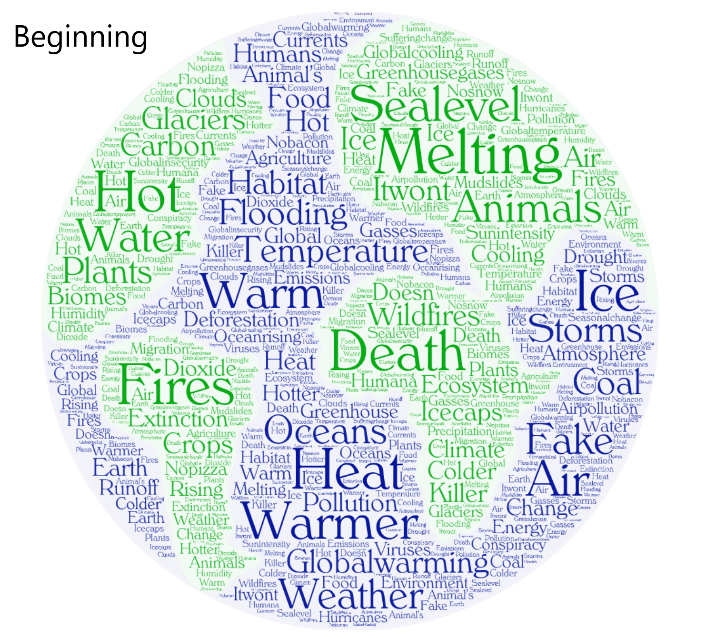
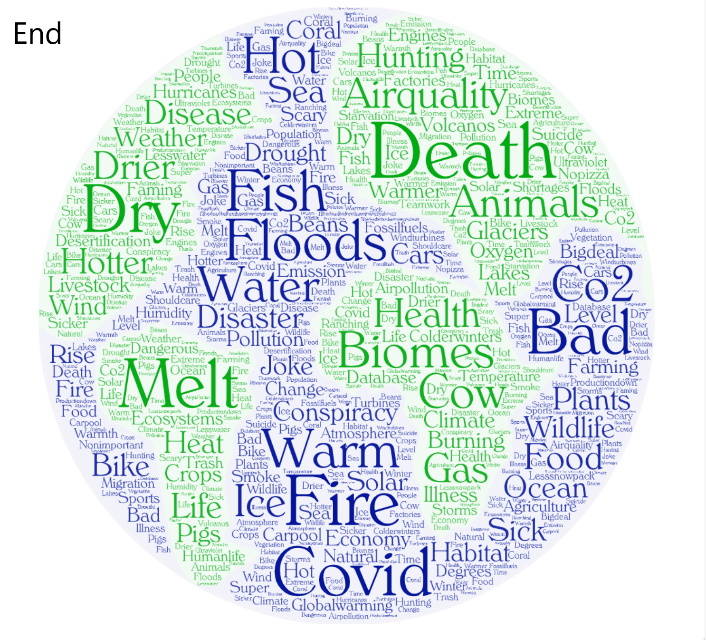
Cheyenne Central High School Outreach
Cheyenne Central High School outreach on March 24th 2021 impacted 45 students in 2 class periods from one teacher. In these two classes, we began with a tour of the neuroscience laboratory as we did at Laramie High School and then walked the students through a simulation in which they were recruited to help solve the Zombie Apocalypse! We started by identifying some behavioral characteristics of zombies and then talked about the different brain regions that must be impacted based on those behaviors. We then introduced the students to how neurons communicate and a couple different neurotransmitters in the brain and their functions. The students learned about antagonists and agonists before being divided into small groups to develop a drug to cure the zombies. The student groups each had a brain map and some skittles. Each skittle color represented a specific neurotransmitter. They worked together to determine which neurotransmitters in which regions of the brain needed to be increased or decreased in their drug cocktail to cure the zombies. The groups then named their drug and presented to us and their classmates on how the drug worked.
Teacher and Student Thank You to the Dana Foundation:
- Thank you for the opportunity to learn alongside UW’s Brainy Bunch. We really enjoyed the tour of the neuroscience labs and meeting the rats. The hands-on learning allowed us to learn more about the brain, neurotransmitters, and their functions. We really appreciated how professors and a graduate student took time out of their day to teach us about their work and their educational backgrounds.
- With the complications of the pandemic, the Brainy Bunch was able to utilize the skills of technology and Zoom to create an interactive experience with us. This was a fantastic introduction into the field of study that the majority of us are interested in. Not only did they answer all our questions, but they also encouraged us to ask questions, be interactive, and learn more about their field of expertise. Our favorite things about the Zoom meeting were seeing the lab, the lab rats, the zombie and Skittles activity, and the squishy brains. We hope other students will have this enriching opportunity in the future.
- The attached PDF has scanned thank you cards with notes from the students too
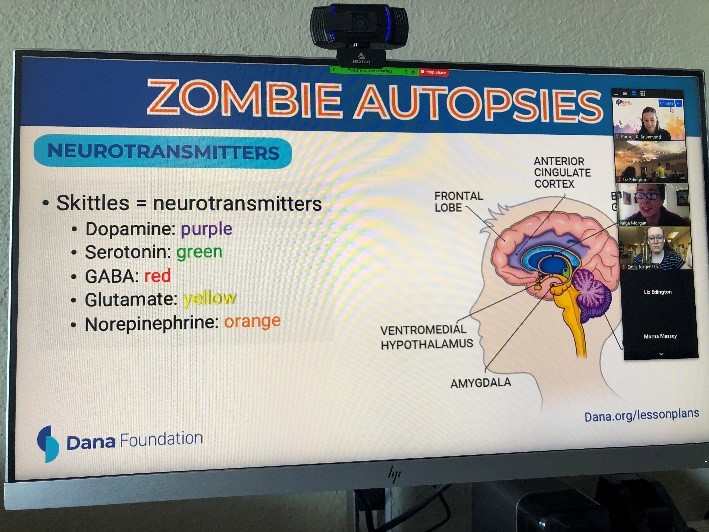
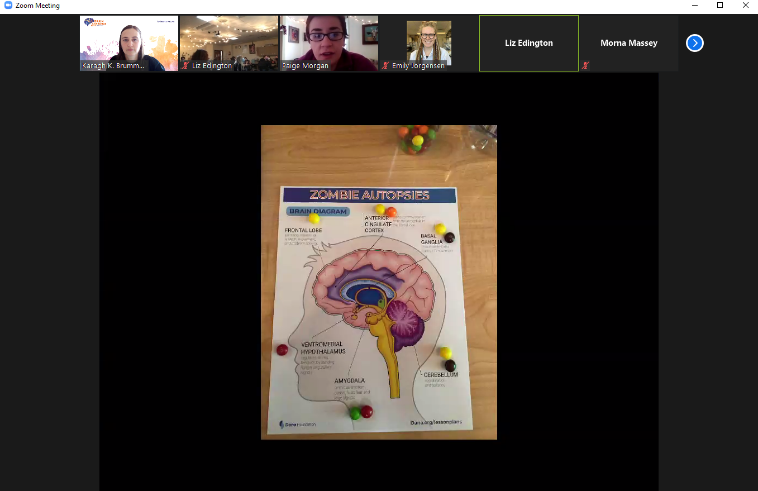
Laramie High School
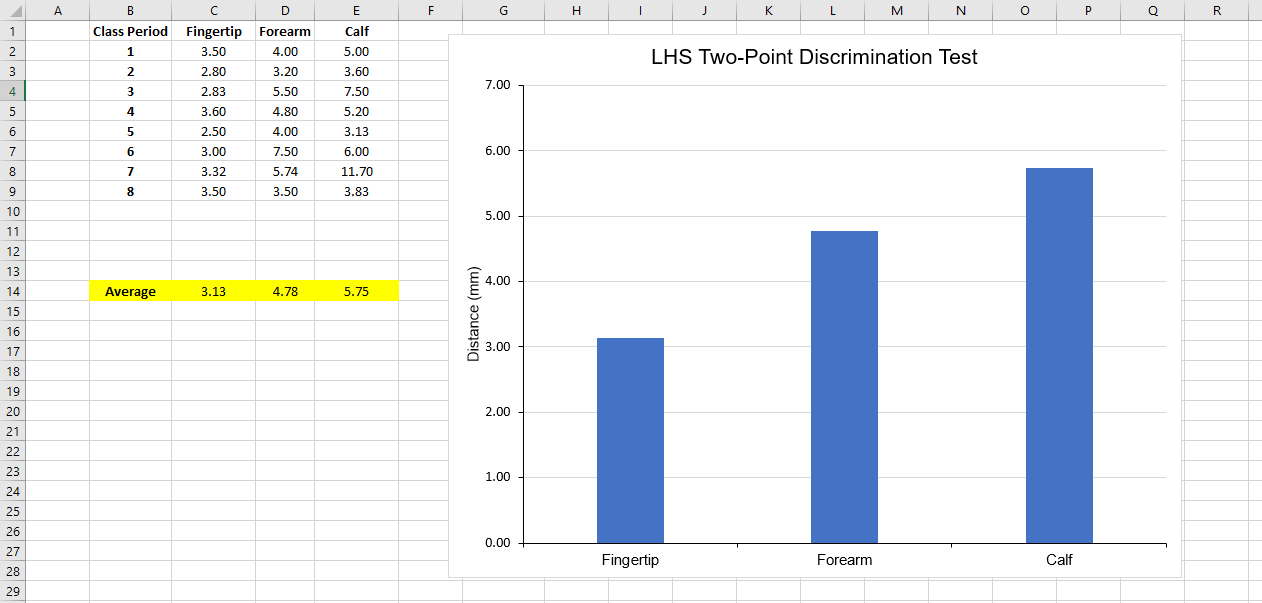
Laramie high school outreach impacted 100 students over the course of 2 full school days (March 8-9th) in 2 teacher classrooms. The outreach began with a virtual laboratory tour of a neuroscience lab on campus complete with ongoing brain slice experiments, behavioral testing, and a vivarium tour of the research rats. Students then engaged with hands-on activities to further build on their understanding of 3 of the 5 senses: taste, touch, and vision. Students tricked their sense of taste using “Miracle Berries” that temporarily modified sour tasting foods to sweet. Students then performed small group experiments to learn about their sense of touch through the 2-point discrimination task. Together we discussed how the brain processes touch and graphed our class data. From the graph we discussed possible conclusions and how the individual class data compared to the pulled data across all classes. Lastly, the students engaged with some optical illusions and learned that they can’t always trust what they see!
Quotes from the Students:
- The presentation was really a nice understanding of telling kids on how some parts of the brain work! Not a lot of people know what parts of the brain control what, but with experiments or cool tricks like lemon and the little sweet tasting pill, they can understand it a lot better! The caliper we used to determine whether what was 2 touches and what was 1, was cool!
- They did a great job with the explanation of how some of the things worked and why the lemon tasted sweet. They also did a great job of showing us around the lab and telling us about some of the great opportunities that they have with the program that they are in.
- I thought that the lemon activity was super cool!! It tasted like I was sucking lemonade right out of the fruit!! (I wish all lemons were like that :) I found it interesting that the "Miracle Berry" pills coated your sour taste-buds with sweet ones.
- I enjoyed seeing their lab rats (literally) at UW, and liked listening to their experiments and hypothesis'. It was fantastic to see what they do.
- The awesome people that came over zoom and gave us a presentation are very nice and I loved to listen to their amazing facts. They taught me things that I'd never even heard of!! It would've been better if they were able to come in-person, but it was an amazing experience to see and learn from them!! Thank you!!
- I liked how they talked about what they did and explained it in a way you could understand and in one case showed us the experiment she was doing with rats. I learned about the berries people eat to turn something sour into something sweet.
- I liked how they showed us the lab with the rats in it. They were also really positive and answered everyone's questions
Neuroscience Outreach
In January 2021, Karagh Brummond received a small outreach grant to build virtual Neuroscience outreach for Wyoming high school psychology students. Karagh has been leading neuroscience engagement for Laramie High School and Cheyenne Central High School psychology students since 2016 called The Brainy Bunch. In wake of the pandemic, the Dana Foundation sent a call for proposals to support outreach efforts in these unprecedented times. Brummond was funded for her outreach efforts and recruited long-time outreach partners Neuroscience PhD candidate Emily Jorgensen and Dr. Paige Morgan (McNair Scholars co-director and Neuroscience PhD graduate) to bring virtual outreach to these high school students.
Sheridan Outreach
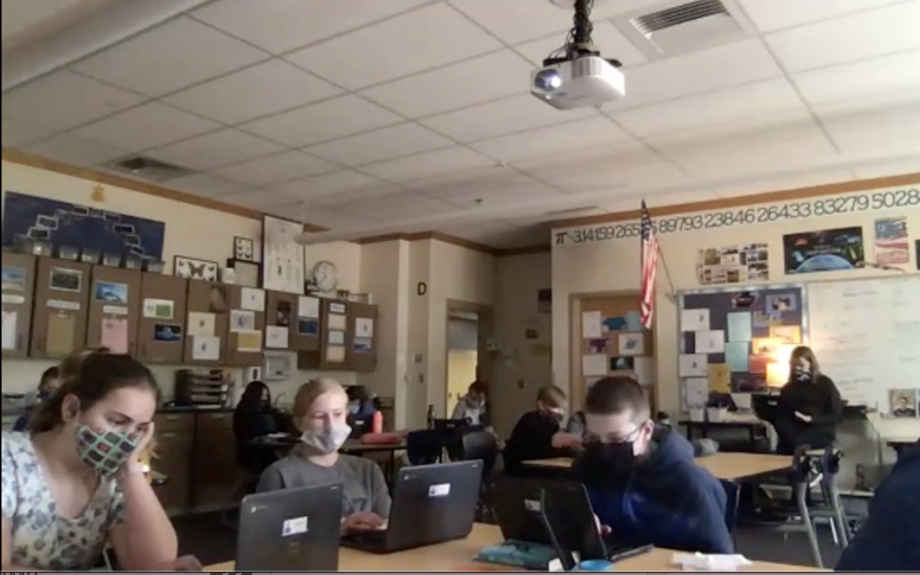 |
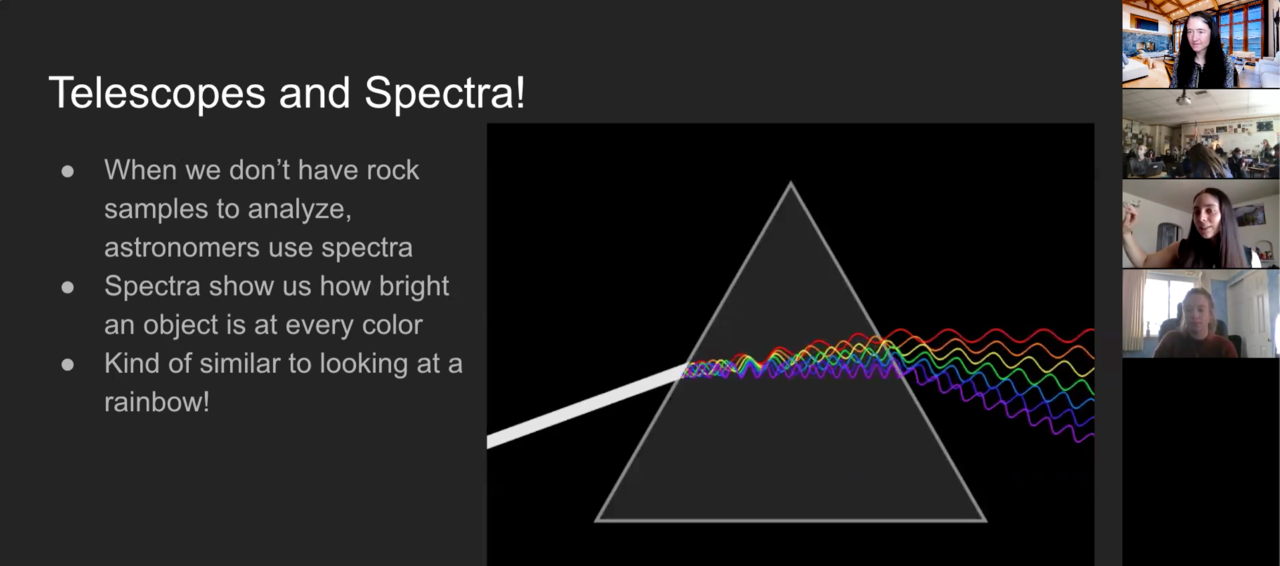 |
On Tuesday, March 30th, Jessica Sutter, Sydney Comet and Rachel Watson led a virtual outreach visit to Sheridan Junior High. The team led an interdisciplinary Astrobiology session with four 6th, 7th and 8th grade classes. Prior to the session, the students prepared by watching a video interview of Dr. Ellen Currano that was led by Jessica. The students learned how to recognize evidence that life may have existed on a planet in the past.
During the class session, Rachel and Sydney reminded the students of the macromolecules that are needed to build life. They helped the students envision a historical abiogenic event in which abiotic factors could be used as precursors to build prebiotic materials and macromolecules. Sydney used an analogy of baking a cake. Eggs (analogous to abiotic molecules) can be used to bake a cake (analogous to macromolecules) but the eggs have to be in the right environment and put together with the right things to make batter (analogous to prebiotic molecules).
Once the students were able to show their knowledge of how they might detect signs of past life or signs that life could be supported, Jessica led them through an activity in which they utilized a simulation (built by Jessica) to determine what levels of ozone, CO2 and water give rise to the planetary atmospheres of Earth, Venus and Mars. This allowed them to speculate as to how spectra can be used to help us determine if there might be life on another planet or moon!
Quotes from the Roadshow Team:
This was my first time using Javascript to facilitate an educational goal. It was exciting to see the students starting to get a hang of how to use the program to model the three atmospheres, but it was also a good reminder to think about keeping things simple for quick activities and always specify the limitations of any simulation! I loved Sydney’s analogy for biogenesis and hope to use that in the future! The highlights for me were the student who speculated about using water to measure spectra and the student who stuck around after to ask if magma was what was creating the geysers on Enceladus. It is always so exciting to hear interesting and brilliant ideas and connections from learners!
What an exciting outreach visit! Jessica’s simulation was so remarkable and interactive.
Everyone got the exciting chance to learn more about looking for life on other planets
and moons, and it was exciting to learn more about the importance of color in astronomy. For me, the highlights were seeing all the incredible questions the students came up with!
Quotes from the Sheridan students and Mrs. Hackworth:
|
"I am so grateful that my students were able to connect to each of you and that you created an interdisciplinary lesson specifically with my students in mind." - Sarah Hackworth (Sheridan Junior High Teacher) |
|
"Thank you for giving some of your time to come and talk to our class! One thing I learned was what macromolecules are and how they could help us find life on Mars. One thing that surprised me was how similar and different Earth's, Venus's, and Mars's atmosphere was. One question I still have is do scientist working with the Mars rover believe to find signs of ancient life similar to life on earth. Thank you so much for coming to our class and teaching us about this awesome subject!" -Student |
|
"Thank you for visiting! I learned about how all planets and the sun have a spectra. I was very surprised that the sun's rays were actually rainbow! I am still very curious about this. I really want to know, do all stars have the same spectra?" -Student |
|
"Thank you for giving me some more knowledge on microbiology and astronomy and paleobotany I had so much fun meeting you guys and I thinking about wanting to be a zoologist because I'm interested in animals and wildlife and if you know anyone who is a zoologist could you maybe ask them what tools they use and what they do and what type of animals they study." -Student |

